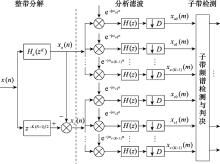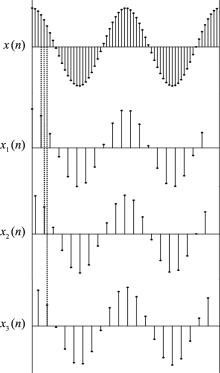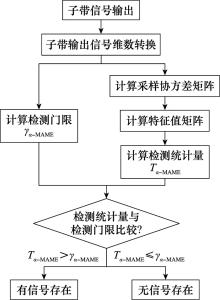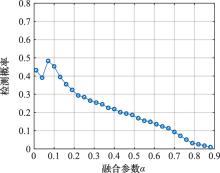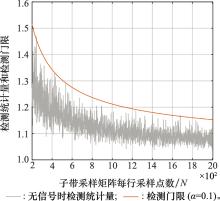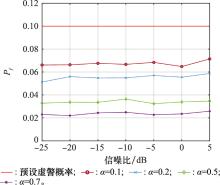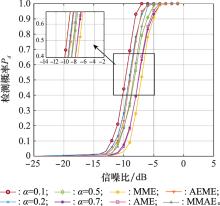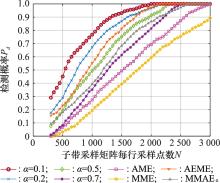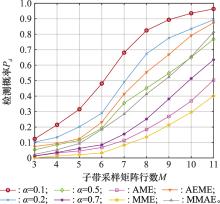| 20 |
WARNER E S , PROUDLER I K . Single-channel blind signal separation of filtered MPSK signals[J]. IEE Proceedings-Radar, Sonar & Navigation, 2003, 150 (6): 396- 402.
|
| 21 |
万宏杰. 动态数字信道化接收结构及子带检测算法研究[D]. 西安: 西安电子科技大学, 2023.
|
|
WAN H J. Research on dynamic digital channelized receiving structure and subband detection algorithm[D]. Xi'an: Xidian University, 2023.
|
| 22 |
NASSER A , AL HAJ HASSAN H , ABOU CHAAYA J , et al. Spectrum sensing for cognitive radio: recent advances and future challenge[J]. Sensors, 2021, 21 (7): 2408.
doi: 10.3390/s21072408
|
| 23 |
BAI Z D . Methodologies in spectoral analysis of large dimensional random marices, a review[J]. Statistica Sinica, 1999, 9, 611- 677.
|
| 24 |
CARDOSO L S, DEBBAH M, BIANCHI P, et al. Cooperative spectrum sensing using random matrix theory[C]//Proc. of the 3rd International Symposium on Wireless Pervasive Computing, 2008.
|
| 25 |
FELDHEIM O N , SODIN S . A universality result for the smallest eigenvalues of certain sample covariance matrices[J]. Geometric and Functional Analysis, 2010, 20 (1): 88- 123.
doi: 10.1007/s00039-010-0055-x
|
| 26 |
TRACY C A , WIDOM H . On orthogonal and symplectic matrix ensembles[J]. Communications in Mathematical Physics, 1996, 177, 727- 754.
doi: 10.1007/BF02099545
|
| 27 |
JOHNSTONE I M . On the distribution of the largest eigenvalue in principal components analysis[J]. The Annals of Statistics, 2001, 29 (2): 295- 327.
|
| 28 |
赵文静, 李贺, 金明录. 基于特征值的频谱感知融合算法[J]. 通信学报, 2019, 40 (11): 57- 64.
|
|
ZHAO W J , LI H , JIN M L . Fusion spectrum sensing algorithm based on eigenvalues[J]. Journal on Communications, 2019, 40 (11): 57- 64.
|
| 1 |
黄知涛, 王翔, 赵雨睿. 认知电子战综述[J]. 国防科技大学学报, 2023, 45 (5): 1- 11.
|
|
HUANG Z T , WANG X , ZHAO Y R . Overview of cognitive electronic warfare[J]. Journal of National University of Defense Technology, 2023, 45 (5): 1- 11.
|
| 2 |
KIM J , UTOMO D R , DISSANAYAKE A , et al. The evolution of channelization receiver architecture: principles and design challenges[J]. IEEE Access, 2017, 5, 25385- 25395.
doi: 10.1109/ACCESS.2017.2772810
|
| 3 |
JIA Z L , LIU H X . An improved blind zone channelization structure and rapid implementation method[J]. Micromachines, 2023, 14 (5): 1091.
doi: 10.3390/mi14051091
|
| 4 |
BAKER D, BEAL A N, JOINER L, et al. A low-cost modified energy detection-based spectrum sensing algorithm with GNU radio for cognitive radio[C]//Proc. of the IEEE Southeast Conference, 2023.
|
| 5 |
ANITORI L, ENDER J. Waveform design for sparse signal processing in radar[C]//Proc. of the IEEE Radar Conference, 2021.
|
| 6 |
李利, 孙剑平, 刘旭波, 等. 基于数字信道化接收和循环谱特征检测的短波频谱感知方法[J]. 中南大学学报(自然科学版), 2013, 44 (10): 4138- 4143.
|
|
LI L , SUN J P , LIU X B , et al. A method of spectrum sensing for HF communication based on digital channelized receiver and cyclic-feature detector[J]. Journal of Central South University(Science and Technology), 2013, 44 (10): 4138- 4143.
|
| 7 |
CHARAN C, PANDEY R. Cooperative spectrum sensing using eigenvalue-based double-threshold detection scheme for cognitive radio networks[C]//Proc. of the Applications of Artificial Intelligence Techniques in Engineering, 2019.
|
| 8 |
王颖喜, 卢光跃. 基于最大最小特征值之差的频谱感知技术研究[J]. 电子与信息学报, 2010, 32 (11): 2571- 2575.
|
|
WANG Y X , LU G Y . DMM based spectrum sensing method for cognitive radio systems[J]. Journal of Electronics & Information Technology, 2010, 32 (11): 2571- 2575.
|
| 29 |
TULINO A M , VERDU S . Random matrix theory and wireless communications[J]. Foundations and Trends in Communications and Information Theory, 2004, 1 (1): 190.
|
| 30 |
TIAN Q, JIANG A P, BI B. Design and FPGA implementation of a digital channelized receiver[C]//Proc. of the IEEE 2nd International Conference on Information Communication and Software Engineering, 2022.
|
| 31 |
PENNA F , GARELLO R , SPIRITO M A . Cooperative spectrum sensing based on the limiting eigenvalue ratio distribution in Wishart matrices[J]. IEEE Communications Letters, 2009, 13 (7): 507- 509.
|
| 9 |
ZENG Y, LIANG Y C. Maximum-minimum eigenvalue detection for cognitive radio[C]//Proc. of the IEEE 18th International Symposium on Personal, Indoor and Mobile Radio Communications, 2007.
|
| 10 |
徐家品, 杨智. 基于随机矩阵特征值比的频谱感知改进算法[J]. 电波科学学报, 2015, 30 (2): 282- 288.
|
|
XU J P , YANG Z . Improved spectrum sensing algorithms based on eigenvalue ratio of random matrix[J]. Chinese Journal of Radio Science, 2015, 30 (2): 282- 288.
|
| 11 |
胡君朋. 宽带无线信号侦测中的动态信道化技术研究[D]. 长沙: 国防科学技术大学, 2017.
|
|
HU J P. Research on dynamic channelization technique for broadband wireless signalreconnaissance[D]. Changsha: National University of Defense Technology, 2017.
|
| 12 |
张春杰, 周振宇, 司伟建, 等. 基于特征值的动态信道化子带频谱检测改进算法[J]. 应用科技, 2020, 47 (5): 20- 28.
|
|
ZHANG C J , ZHOU Z Y , SI W J , et al. Dynamic channelization subband spectrum sensing based on eigenvalue[J]. Applied Science and Technology, 2020, 47 (5): 20- 28.
|
| 13 |
LIU C , WANG J , LIU X M , et al. Maximum eigenvalue-based goodness-of-fit detection for spectrum sensing in cognitive radio[J]. IEEE Trans. on Vehicular Technology, 2019, 68 (8): 7747- 7760.
doi: 10.1109/TVT.2019.2923648
|
| 14 |
ZHANG D , ZHENG H , ZHANG L P . Efficient channe-lized technology based on filter banks[J]. Journal of Mea-surement Science & Instrumentation, 2016, 7 (3): 261.
|
| 15 |
CHENG W H , ZHANG Q Y , WEI L , et al. An efficient digital channelized receiver for low SNR and wideband chirp signals detection[J]. Applied Sciences, 2023, 13 (5): 3080.
doi: 10.3390/app13053080
|
| 16 |
SHI L , HUANG Z , FENG X F . Design and implementation of partial shared digital channelized receiver[J]. Journal of Beijing Institute of Technology, 2021, 30 (2): 186- 193.
|
| 17 |
刘佳. 单通道盲源分离及其在水声信号处理中的应用研究[D]. 哈尔滨: 哈尔滨工程大学, 2011.
|
|
LIU J. Reseach on single channel blind source separation and its application in underwater acoustic signal processing[D]. Harbin: Harbin Engineering University, 2011.
|
| 18 |
赵艳. 子带技术研究及其在宽带信号处理中的应用[D]. 郑州: 解放军信息工程大学, 2012.
|
|
ZHAO Y. Subband technologies research and its applications in wideband signal processing[D]. Zhengzhou: Information Engineering University, 2012.
|
| 19 |
GAO B , WOO W L , DLAY S S . Single-channel source separation using EMD-subband variable regularized sparse features[J]. IEEE Trans. on Audio, Speech, and Language Processing, 2010, 19 (4): 961- 976.
|
